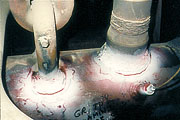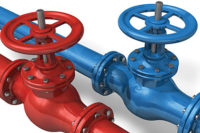
However, once built and installed, the postconstruction regulation for this equipment is left to the auspices of local governmental jurisdictions that have adopted the National Board Inspection Code (NBIC). Like the ASME code, the NBIC was created for the purpose of promoting safety by establishing uniform rules related to the inspection and repair of equipment built to the ASME code. Provided that a pressure component is affixed with an ASME symbol and it is satisfactorily inspected and repaired in accordance with the NBIC, it is generally recognized that the object is considered suitable for continued service.
Since the inception of the ASME Code and the NBIC, this protocol for safety has successfully demonstrated its effectiveness over the years by reducing the incidence and severity of industrial accidents related to boilers and pressure vessel equipment. However, while the overall safety has improved, this doctrine does not provide the type of information necessary for establishing life extension considerations in support of asset management decisions.
To adequately manage the pressure equipment assets, a more detailed inspection program is required than can be achieved by traditional safety inspections. Therefore, an organization must affirmatively decide that it is going to manage its pressurized equipment as capital assets, then approach the whole business of equipment inspections from a new perspective.

The Decisionmaking Process
There are a number of reasons that may prompt plant engineering and management to consider implementation of an equipment condition and assessment program. Reasons may range from simple validation of boiler and pressure vessel condition to complex engineering analysis. Whatever the reasons may be, a number of factors need to be considered when developing an effective and useful inspection and assessment program.The decision to evaluate and assess the condition of boilers, pressure vessels, and other plant equipment is generally centered on financial issues. A plant may be looking to reduce maintenance costs, increase plant production, improve operational reliability, purchase a piece of used equipment, or make a repair/replace decision. Regardless of the specific reason, the end result will impact an organization’s financial performance. A carefully developed assessment program will ensure positive financial impact.
Any organization that relies on boilers and pressure vessels in critical processes or heating should have some form of inspection and assessment program. The depth of an inspection program can vary dramatically depending on equipment and organizational objectives. Simple verification of equipment condition may only involve a basic inspection combined with a review of pertinent operating and repair records. This very basic approach is often used as a preliminary phase in determining the scope of a more specific, in-depth assessment program.
It is appropriate to recognize that the most effective assessment programs are dynamic; they change over time as the needs and objectives of an organization change. Assessment is not a one-time event, but a continuing process.

Verifying Objectives
Once an organization has committed to an inspection program for managing its assets, a clearly stated objective needs to be established. Objectives are established and driven by a number of factors that influence every step in the planning and implementation stages of the program. The objectives must be closely related to the strategic vision and long-term plans of the organization.Improved maintenance planning and budgeting is a good example of one equipment assessment program objective. In the fairly recent past, there has been a tremendous amount of information developed regarding improved maintenance practices. Preventive-, predictive-, and reliability-centered maintenance programs are but a few of the many approaches promoted by a large number of companies that provide maintenance solutions. These approaches all have a tremendous amount of value when properly implemented and administered. When they fail to deliver savings or improved reliability, it is almost always due to the fact that there wasn’t any consideration given to equipment condition assessment as an integral portion of the upfront planning process.
Even the most effective maintenance program will fail when applied to aging equipment in need of extensive renovation, repair, or replacement. It is simply not possible to put an effective maintenance program in place without a thorough understanding of equipment condition.
Capital asset planning is another example of an objective that can be successfully managed as an extension of inspection and assessment programs. Equipment such as boilers, pressure vessels, process equipment, and systems are typically classified as capital and generally considered to be assets, because their value diminishes over time and is depreciated according to appropriate accounting practice. This equipment is maintained and operated based on sound engineering principles and available funding.
Finding the right balance between engineering and funding can be one of the most significant challenges facing plant management today. Although labeling major equipment as capital assets is nothing new, the way we manage this equipment can change significantly when we introduce the combination of condition assessment, managed maintenance practices, and financial planning.
Whether an organization’s objective is improved maintenance planning, more effective capital asset management, planning for anticipated plant expansion, making informed decisions regarding repair or replacement of critical equipment, or simply addressing general concerns related to the facility’s pressure vessels, the need for an overall assessment program is essential.
Understanding the Risks
The first order of consideration when formulating an assessment program is understanding the risk associated with the system. A system may constitute an entire process or a single component within a process (piping, pressure vessel, etc.). By evaluating the risk, an inspection planner may better identify which aspects of the system should receive the highest level of inspection priority based on risk factors. This evaluation process considers the probability of failure and the consequence of failure in the development of an inspection plan.Risk-based assessment guidelines have been created by several technical societies, most notably the ASME and API. Through a structured evaluation process following established guidelines, the practitioner of a risk-based evaluation is able to validate the level of inspection detail and frequency necessary to comply with the organization’s strategic financial objective.
Depending upon the level of sophistication, the evaluation may range from a fundamental qualitative assessment to an extensive, fully quantitative analysis using highly developed probabilistic models. By incorporating a risk-based evaluation approach, an inspection plan can be developed that optimizes the timing of resources as supported by financial considerations of risk.
Assessment Mechanics
A general assessment is one that considers both the physical and operational attributes of the equipment. The assessment of physical attributes includes an evaluation of the hardware to verify material properties, the presence of discontinuities, and visual indicators warning of underlying problems. Singularly, this information provides a momentary snapshot of the assets’ present condition. However, by incorporating an evaluation of the operational attributes, relative to past, present, and future utilization patterns, it is possible to project future trends and expectations for the equipment.Any assessment program begins with the most fundamental of inspection techniques — visual examination. When conducted by experienced personnel, a visual examination can provide invaluable information and be used to develop and refine a final inspection plan.
Most all inspection plans will include a combination of nondestructive and possibly destructive testing techniques. The most common techniques include ultrasonic testing, magnetic particle or liquid penetrant examination, hardness testing, metallurgical evaluations, and material analysis. Other specialized methods may be used on an as needed basis.
Ultrasonic measurements of material thickness are obtained to quantify the severity of material loss due to corrosion or erosion. Current thickness data, when compared to manufacturer’s original design specifications, can be used to develop depletion rates. Understanding the depletion rate of equipment can assist in both the planning and budgeting for major equipment repair and replacement.
Under ideal operating conditions, stresses imparted on pressure equipment are minimal. Unfortunately, equipment is typically not operated under ideal conditions. Pressure equipment is subjected to temperature and pressure variations as a result of fluctuating load demands. This has a potentially detrimental effect on the fatigue life of the equipment. To evaluate the effect of operations on pressure equipment, material surfaces are examined using nondestructive methods in order to identify evidence of surface discontinuities indicative of cracking. Any indications are noted for further in-depth evaluation.
Changes in the metallurgical properties of materials used in the fabrication of boilers and pressure vessel equipment subject to high temperatures can occur when the equipment is exposed to conditions higher than design. The effect this exposure can have on material can include a reduction in material strength and ductility. When historical data indicates a high-temperature event has occurred, or if there is evidence of material deformation, metallurgical evaluations incorporating replications or hardness testing are warranted. In situ metallurgical analysis is generally a viable option. However, it may be necessary to remove material samples for more extensive laboratory testing.
The final step in the assessment phase is to compile all of the inspection data into a final report. This comprehensive report should provide a complete profile of equipment condition with specific reference to areas of concern and recommended corrective action. Using the baseline assessment, a long-term strategy for equipment management can be developed.
Selecting the Right Partner
Selecting the right inspection and engineering contractor to perform a condition assessment is a critical element in the project development process. There are generally four categories of qualified contractor candidates available to support a condition assessment program: NDE companies, repair firms, consultants, and the original equipment manufacturer (OEM). However, not all are created equal. Factors to consider when selecting a contractor should include experience, objectivity, capabilities, resources, and financial stability.The qualifications and experience brought to the project by a contractor familiar with the equipment is essential. A good contractor will use this experience to help manage the facility’s expectations, assuring a successful condition assessment. The contractor should demonstrate an ability to provide guidance to the facility engineer from the earliest stages of the project development through project completion.
It is not uncommon to have contracts awarded by the purchasing department based on the lowest bidder with no regard to the recommendations from engineering. While this may make economic sense from an accounting perspective, it is wise to be wary of add-on charges. Even the most reputable firm may submit a low bid to secure a project with an expectation of generating additional work through repairs or aftermarket sale of parts. Firms possessing the prerequisite work experience but without a financial stake in the sale of additional products or services have a tendency to be more objective with regards to recommendations.
A contractor’s capabilities should conform to the mission of the assessment program. It is important that there is a mutual understanding with the contractor of the service expectations. This includes an understanding of what services the facility will provide. If a project requires an engineering evaluation of inspection data, then selecting a testing firm may prove inadequate. Conversely, choosing an engineering organization for the express purpose of recording thickness measurements may cost more than necessary.
Additionally, a contractor’s financial stability may have significant ramifications on the project planning. A contractor that has closed shop may derail a project planned several months in advance. The security of project documentation compiled during the data collection phase of the project may be lost if the contractor goes out of business midway through the project. Considering that an effective condition assessment program is an ongoing process, the continuity of information is undermined on long-term projects should the contractor be unable to honor the contract because of financial reasons.
Conclusion
Successfully managing assets associated with pressure vessel equipment requires an awareness of the physical condition of the equipment. Information obtained from routine annual inspections mandated by regulatory agencies generally is not sufficient for the purposes of asset management. Because there is not an unlimited resource of funding to sustain a detailed assessment of every system or its components, a process of prioritizing an inspection plan on a risk-based approach offers significant advantages to the inspection planner.While the process of inspection will vary according to the individual risk factors, the actual performance of an assessment program will hinge upon selecting the right contracting partner for the project. The benefits acquired from conducting a condition assessment will empower the facility manager to make informed decisions affecting the strategic goals of the organization. ES

